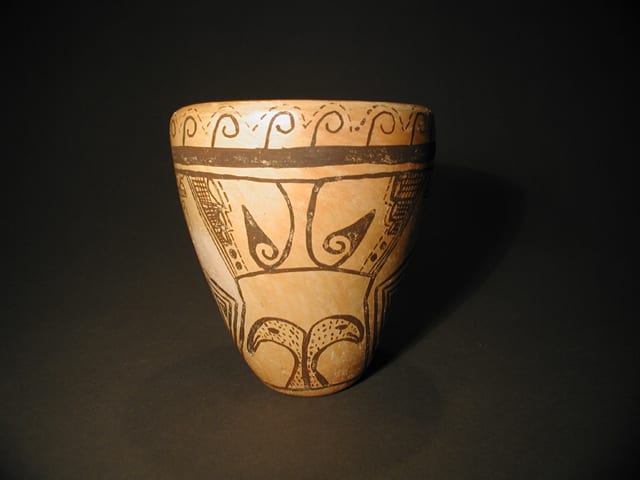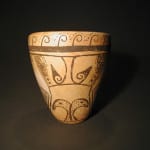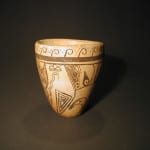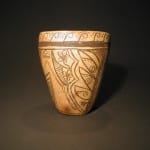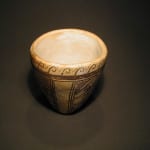Germination pot, tapered, with complex, symbolic, monochromatic painting, unsigned.
This is the most unusual, complex, and enigmatic vessel in the collection. There are two framing lines near the top of the vessel: a thick line and below it a thin line that encircles the top of this pot. There is a row of curls above the framing lines. Below these lines there is a large central panel of images: two rainbird symbols placed back-to-back and below them a pair of turkey (snake?) heads, also facing in opposite directions. On either side of this central panel are the same complex pattern of designs: crosshatching, a squared spiral, the clear symbol for rain clouds, a snake, flowers, etc. As these two panels wrap around the vessel, they do not meet. On the back of the pot is an undecorated strip 0.5” to about 1.0” wide running from the bottom of the vessel to the framing lines.
Ed Wade (4/23/09) examined images of the pot and says the closest he has seen to this design was a pot excavated at the ruin of San Bernardino church. The excavated jar was apparently made for use in the mass. What I see as two turkey heads on 2001-04, Wade describes as derived from Mexico’s Emperor Maximilian’s two-headed eagle insignia.
The painting of this pot is carefully done; the layout is clearly deliberate. Since some of the symbols are well known (the rain clouds and snakes) and are used for ritual purpose, there is a temptation to assume that all of the symbols have meaning . It seems unlikely that this is just a doodle and yet one should be cautious about assuming that the symbols can be read like a book and produce some unified understanding. I have seen no other Hopi pot that even comes close to having this pattern of design, thus I cannot place this pot in some defined category to help us understand it.
Patterson’s discussion of Alexander Stephen’s catalogue of the Keam collection (1994) suggest numerous interpretations of pottery symbols. It is somewhat problematic whether such interpretations were justified in the 1890s; even more problematic that these interpretations can be projected onto this pot.
Nevertheless, given that some of the symbols on this pot are unambiguous while others are quite uncertain, an attempt might be made to “read” the complex decoration of this vessel. Following Patterson:
• The curls encircling the rim of the vessel above the framing lines are said to be ornamental locks of hair (lovelocks) worn by maidens (1994:196).
• The two large rainbird symbols in the central pattern are Zuni derived and represent willow twigs that are bent back upon themselves and fastened, the resulting form used as a drumbeater, making thunder noises and brining rain. Alternatively these two symbols might be cotyledons representing sprouting plants (1994:151).
• The two heads might be bird (turkey?) heads or snakeheads, Maximilian’s two-headed eagle crescent or an entirely different animal.
• If they are turkey heads, Patterson writes that this is because the turkey “is only found near water (and thus) is regarded as an emblem of the element” (1994:88). Somewhat similar heads were used by Alma Tahbo to decorate a small dish formed by her mother, Grace Chapella (see 1993-01). Similar turkey heads also are found on a tile in the Museum of Northern Arizona collection, see Allen (1984:59, #E805). If snake heads, they serve as carriers of prayers to the underworld of ancestors. These figures are the central image of the pot, yet remain difficult to define.
• The crosshatching with associated dots might be interpreted as gardens or cultivated fields. (1994:164).
• The triangular spirals might represent Ho-bo bo (The Twister) or breath spirals configured into a triangle. Alternatively, this spiral might represent flowing water (1994:29, 240).
• The two full-body rattlesnakes represent messengers to ancestors in the underworld, and hence to the kachinas and gods, who carry the prayers of the people for moisture. These are the central image of the snake dance, for example.
• The two Hopi cloud images incorporate lightening and rain and are the most unambiguous of the symbols used on this pot (1994:143).
If these interpretations mean anything (and I think that in their totality they do), then this pot –like most Hopi religious symbolism—is a statement of the forces of germination and more broadly, blessing and life. It would be wonderful to discuss the pot with its maker. While this is an obvious impossibility, no other Hopi pot that I know of tries to speak its meaning more directly.

